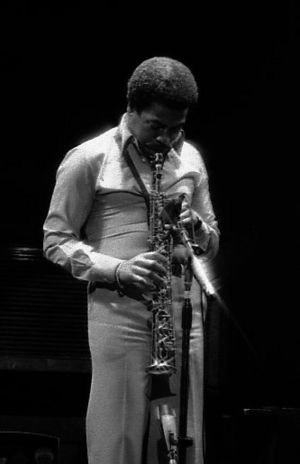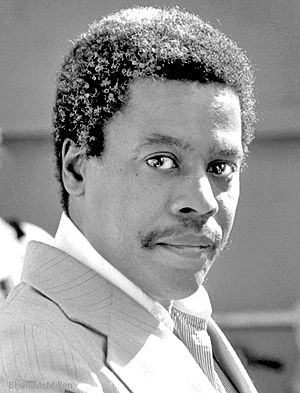Wayne Shorter facts for kids
Quick facts for kids
Wayne Shorter
|
|
|---|---|

Shorter in 1977
|
|
| Background information | |
| Born | August 25, 1933 Newark, New Jersey, U.S. |
| Died | March 2, 2023 (aged 89) Los Angeles, California, U.S. |
| Genres | Modal jazz, crossover jazz, post-bop, hard bop, jazz fusion, third stream |
| Occupation(s) | Musician, composer |
| Instruments | Tenor saxophone, soprano saxophone |
| Years active | 1958–2021 |
| Labels | Blue Note, Columbia, Verve |
Wayne Shorter (born August 25, 1933 – died March 2, 2023) was an American jazz musician. He was famous for playing the saxophone and writing music. Wayne became well-known in the late 1950s. He was a member of a band called Art Blakey's Jazz Messengers. He even became their main composer, meaning he wrote most of their songs.
In the 1960s, Wayne joined Miles Davis's amazing band, the Second Great Quintet. Later, he helped start the jazz fusion band Weather Report. He released more than 20 albums as a band leader. Many of his songs are now considered jazz classics. Wayne won 12 Grammy Awards for his music. People praised him for how well he played the soprano saxophone. He was called "probably jazz's greatest living small-group composer." In 2017, he received the Polar Music Prize, a very important music award.
Contents
Early Life and Music Journey
Wayne Shorter was born in Newark, New Jersey. He went to Newark Arts High School and finished in 1952. His father encouraged him to play the clarinet when he was a teenager. His older brother, Alan, also played music.
After high school, Wayne studied music at New York University. He graduated in 1956. Then, he spent two years in the U.S. Army. During this time, he played music briefly with Horace Silver. After leaving the army, he played with Maynard Ferguson. When he was young, people called him "Mr. Gone." This nickname later became the title of an album by Weather Report.
Starting His Career
Wayne Shorter was inspired by other great jazz musicians like Sonny Rollins and John Coltrane. In 1959, he joined Art Blakey's Jazz Messengers. He stayed with them for four years. He even became the band's musical director and wrote many songs for them.
They traveled and played music in the US, Japan, and Europe. They also recorded several albums together. During this time, Wayne became known as one of the most talented young saxophonists. He gained fame around the world.
Playing with Miles Davis (1964–1970)
Herbie Hancock, another famous musician, said that Wayne was the "master writer" in Miles Davis's band. Miles Davis himself said that Wayne was a "real composer." He wrote music exactly how he wanted it to sound. Miles also said Wayne understood how to use music rules and how to bend them in a smart way.
Another musician, Ian Carr, said that with Miles Davis, Wayne found his unique style. Playing with Miles's band allowed Wayne to explore new feelings and ways of playing. He played his last live shows and recordings with Miles Davis in 1970.
Until 1968, Wayne mostly played the tenor saxophone. In 1969, he started playing the soprano saxophone on Miles Davis's album In a Silent Way. He also played it on his own album, Super Nova. By the early 1970s, he mainly played the soprano saxophone.
Solo Albums with Blue Note
While he was with Miles Davis, Wayne also recorded many albums for Blue Note Records. These albums mostly featured his own songs. He played with different groups, including famous musicians like Freddie Hubbard.
His first Blue Note album was Night Dreamer in 1964. He recorded two more albums that year: JuJu and Speak No Evil. In 1965, he recorded The All Seeing Eye with a larger group. Then, in 1966, he recorded Adam's Apple with a quartet. He also played as a guest musician on other artists' albums, mostly for Blue Note.
Forming Weather Report (1971–1986)
After releasing his album Odyssey of Iska in 1970, Wayne started a new band called Weather Report. He formed it with keyboard player Joe Zawinul and bassist Miroslav Vitous. Other original members included Airto Moreira and Alphonse Mouzon.
After Vitous left in 1973, Wayne and Zawinul led the band together until it broke up in 1985. Many different musicians played in Weather Report over the years. One famous member was the bassist Jaco Pastorius. The band made many great recordings with different styles, including funk, bebop, Latin jazz, and world music.
Special Projects and Collaborations
Wayne also made popular solo albums. One of them was Native Dancer in 1974. On this album, he worked with Herbie Hancock and Brazilian singer Milton Nascimento.
In the late 1970s and early 1980s, he toured with the V.S.O.P. quintet. This group was like a reunion of the 1960s Miles Davis band, but with Freddie Hubbard playing trumpet. Wayne also played on Carlos Santana's album The Swing of Delight in 1980.
From 1977 to 2002, he played on 10 albums by the singer Joni Mitchell. This helped him reach even more listeners. He also played a long saxophone solo on the song "Aja" from Steely Dan's 1977 album Aja.
Later Years and New Music
After Weather Report ended in 1986, Wayne kept making and leading jazz fusion groups. He toured with guitarist Carlos Santana in 1988. In 1989, he played the saxophone solo on Don Henley's hit song "The End of the Innocence." He also worked with Herbie Hancock again on a tribute album after Miles Davis passed away.
Wayne continued to play on Joni Mitchell's albums in the 1990s. You can also hear his music on the soundtrack for the movie The Fugitive (1993).
In 1995, Wayne released High Life, his first solo album in seven years. He wrote all the songs and co-produced it. High Life won a Grammy Award for Best Contemporary Jazz Album in 1997.
In 1997, Wayne worked with Herbie Hancock again on the album 1+1. Their song "Aung San Suu Kyi" won them both a Grammy Award. In 2013, his live album Without a Net was released.
The Wayne Shorter Quartet
In 2000, Wayne formed his first steady acoustic band, a quartet. It included pianist Danilo Perez, bassist John Patitucci, and drummer Brian Blade. They played Wayne's own songs, many of them new versions of older tunes.
They released four live albums: Footprints Live! (2002), Beyond the Sound Barrier (2005), Without a Net (2013), and Emanon (2018). The quartet received great praise, especially for Wayne's tenor saxophone playing. Beyond the Sound Barrier won a Grammy Award in 2006.
Wayne's 2003 album Alegría also won a Grammy Award in 2004. It featured his quartet and many other musicians. The songs on Alegría had complex Latin rhythms, a style Wayne often used in Weather Report.
Mega Nova and (Iphigenia)
In 2016, it was announced that Wayne Shorter, Carlos Santana, and Herbie Hancock would tour together as a "supergroup" called Mega Nova. They had their first show in August 2016.
In 2018, Wayne stopped performing live due to health reasons. However, he continued to compose music. He created a new opera called (Iphigenia). Esperanza Spalding wrote the story for it, and architect Frank Gehry designed the sets. It premiered in November 2021.
Awards and Honors
Wayne Shorter received many awards and honors throughout his life.
- In 1999, he received an Honorary Doctorate of Music from the Berklee College of Music.
- In 2013, he received a Lifetime Achievement Award from the Thelonious Monk Institute of Jazz.
- In 2014, the Recording Academy gave him the Grammy Lifetime Achievement Award. This award honored his huge contributions to music and culture.
- In 2016, he received a Guggenheim Fellowship for music composition. He was the only jazz artist to get this honor that year.
- In 2017, he won the Polar Music Prize, a very prestigious international music award. The award committee said, "Without the musical explorations of Wayne Shorter, modern music would not have drilled so deep."
- In 2018, Wayne received the Kennedy Center Honors Award. This award recognizes artists for their lifetime contributions to the arts.
He won many Grammy Awards for his albums and compositions, including:
- 1979: 8:30 (with Weather Report)
- 1987: "Call Sheet Blues" (with Herbie Hancock, Ron Carter, and Billy Higgins)
- 1994: A Tribute to Miles
- 1996: High Life (Best Contemporary Jazz Album)
- 1997: "Aung San Suu Kyi" (with Herbie Hancock)
- 1999: "In Walked Wayne"
- 2003: "Sacajawea" and Alegría
- 2005: Beyond the Sound Barrier
- 2014: "Orbits"
- 2019: Emanon (Best Jazz Instrumental Album)
He also won many "Player of the Year" awards for his saxophone playing from DownBeat magazine.
Discography
- Introducing Wayne Shorter (1959)
- Wayning Moments (1962)
- Night Dreamer (1964)
- JuJu (1964)
- Speak No Evil (1966)
- Adam's Apple (1967)
- Super Nova (1969)
- Odyssey of Iska (1971)
- Native Dancer (1975)
- Atlantis (1985)
- High Life (1995)
- 1+1 (1997)
- Footprints Live! (2002)
- Alegría (2003)
- Beyond the Sound Barrier (2005)
- Without a Net (2013)
- Emanon (2018)
His Personal Journey
Wayne Shorter married Teruko (Irene) Nakagami in 1961. They had a daughter named Miyako. Some of Wayne's songs are named "Miyako" and "Infant Eyes" after his daughter. They separated in 1964.
Wayne later married Ana Maria Patricio in 1970. Sadly, their daughter Iska passed away at age 14 in 1986. In 1996, Ana Maria and their niece, Dalila, also passed away in a tragic accident while traveling. In 1999, Wayne married Carolina Dos Santos, who was a close friend of Ana Maria.
Wayne Shorter practiced Nichiren Buddhism for over 50 years. He was a longtime member of the Buddhist group Soka Gakkai International.
Wayne Shorter passed away in Los Angeles, California, on March 2, 2023, at the age of 89.
Images for kids
See also
 In Spanish: Wayne Shorter para niños
In Spanish: Wayne Shorter para niños










